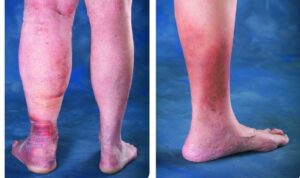Have you noticed the skin on your feet turn darker than other areas of your skin? Are you concerned that this may be a cause for concern? Well, if you are--you're right! Darkening skin in your feet can be a sign of several different vein conditions. And all of them should be brought to your doctor's attention.

For light skinned individuals, several things can cause your feet to turn darker. In fact, feet that are darker than the rest of your skin can be a side effect of varicose veins. When you have varicose veins (incompetent veins that aren't functioning properly) blood pools in your legs. And that leads to swelling--both in your veins and possibly in your legs themselves. In some instances, red blood cells may leak outside the varicose veins. These cells carry some red pigment that, over time, may turn black in color. When these cells end up in your feet, they may contribute to the darker skin color.
While an abundance of red blood cells may cause your feet to change color, lack of blood flow may also affect the appearance of your feet. As plaque builds up in our bodies due to fat and cholesterol, a condition known as Peripheral Arterial Diesease (PAD) may set in. PAD occurs when plaque sticks to your arteries, narrowing them significantly and thus affecting blood flow throughout your body. With PAD, less oxygen-rich blood may reach your feet. In contrast to skin darkening related to varicose veins, color changes related to PAD are unlikely to be accompanied by swelling. Additionally, your dark feet are likely to feel cold or even numb.
While internal factors can certainly contribute to changes in the color of your feet, it's also important to examine problems in your own habits. Smokers especially may notice marked changes in their skin color:
While all these factors are less common, they could also change the color of your feet. Eczema, when it manifests on your feet can change the color of your skin tone. Another condition called venous eczema, or stasis dermatitis, can also change the color of your feet or legs. With this inflammatory skin condition, your legs, ankles and feet may swell or show signs of inflammation. Aside from changing color, affected skin can feel dry, irritated and itchy.
Stasis dermatitis may develop with chronic venous insufficiency, or circulatory problems. But it's not the only health concern that can change your leg color. Because Kaposi's sarcoma, a rare form of cancer that forms in lymph and blood vessels, can also make the skin on your feet appear darker due to the lesions that characterize this condition.
Regardless of the reason for the change, when the skin on your feet turns dramatically darker, it should be cause for more than just cosmetic concern. All of the things that change the color of the feet will need medical attention, so this is one symptom you should never dismiss or ignore.
Now, when you come in for your vein consultation, your specialist will give you treatment options. You've got many choices when you want to treat varicose veins. But one choice, sclerotherapy, probably won't be an option. You see, sclerotherapy is mostly a cosmetic treatment.
Of course, this is a great option if all you want is younger looking legs. It's very effective when you're dealing with spider veins, but not when you have varicose veins. And, if your feet turn darker, your disease is likely more serious. So you'll need greater interventions to improve your health, and your leg and foot appearance.
Ready to make a big step towards reversing the skin damage of varicose veins? Come into our office right awayCome into our office right awayCome into our office right away. We'll conduct a thorough examination and figure out your next best course of action.
Sources: Flux Magazine

Scheduling
Please contact our dedicated specialists to schedule a consultation today.
2024 Texas Endovascular. All rights reserved. Website Design by Healthcare Success